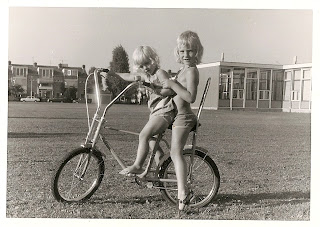Voor de Nederlandse tekst, zie na de Engelse tekst.
Two of my wife's grandfathers were blue collar workers. When they grew up around 1900, any education beyond grammar school was reserved for the happy few. To the best of my knowledge they were happy but in no way part of the few.
Her maternal grandfather was Homme Venema born in Muntendam (Gr.) on Christmas Day 1889. His ancestors were farmers and artisans. Whether he also worked the land during his youth, I don't know. But I do know he worked in a coarse forge/machine factory and at Holtman's shipyard. The shipyard was in Stadskanaal (Gr.), the machine factory possibly as well.
After moving to The Hague he was a copper smith in the business of his brother in law. Also he worked for a steel(?) company named Mudde.
Homme's working life spanned some 55 years! So when he stopped working, he had every right to say: let's call it a day.
 |
Homme Venema (1889-1965) stands to the right of the gentleman with
the waistcoat, the folded arms and the driver's cap.
The text on the sign says: Coarse Forge - Machine & Winches Factory |
The other grandfather, Nicolaas Orie (Loosduinen (ZH), November 1, 1897) started as an electrician and with that he copied his father's profession. But unlike his father, who was a civil servant with the municipal electricity company of The Hague (GEB), he started his own business. Later he began a bicycle shop. A large part of his working life must have been spent on managing his family. He had 14 children. Obviously his wife, Adriana van Asten, played an important part here but still...
 |
| Nicolaas Orie (1897-1977) after his retirement busy manufacturing an operational miniature steam engine for one of his many grandsons. |
Nicolaas was also a meritorious painter with an enormous production. We could do him no greater pleasure than presenting him a piece of prestressed linen. Although he never made any money with painting, I'm sure it was his favorite pass time.
 |
| Fishing boats on the beach by Nicolaas Orie |
In case you wonder whether my wife has inherited any of the technical capabilities of both her grandfathers, the answer is yes. She says.
Samenvatting
Twee grootvaders van mijn vrouw waren handwerkslieden. In de tijd dat zij opgroeiden, rond de vorige eeuwwisseling, was doorstuderen na de lagere school alleen voor de welgestelden weggelegd.
Haar grootvader van moeder's zijde was Homme Venema (Muntendam (Gr.), 25-12-1889). Zijn voorouders waren boeren en ambachtslieden. Ik weet niet of hij in zijn jeugd ook op het land heeft gewerkt maar zeker wel in een grofsmederij annex machine & lierenfabriek en bij de scheepswerf van Holman in Stadskanaal (op de hoek van de Brugkade en de Hoofdkade). Mogelijk was de smederij ook in Stadskanaal gevestigd. Na verhuizing naar Den Haag werkte hij als koperslager bij zijn zwager (Henderikus Klopstra) in de Scheeperstraat 157. Daarna ook nog bij een staal(?)bedrijf genaamd Mudde.
Zijn werkzame leven overspande een periode van ongeveer 55 jaar! Kom daar vandaag de dag nog eens om. Hoewel, je weet maar nooit wat de toekomst nog in petto heeft...
De andere grootvader is Nicolaas Orie, geboren op 1-11-1897 in het toen nog een zelfstandig dorp zijnde Loosduinen. Net zoals zijn vader, werd hij electricien. Alleen begon hij voor zichzelf terwijl zijn vader in dienst was van het GEB, het Gemeentelijk Electrisch Bedrijf van Den Haag. Later zou hij ook nog een fietsenwinkel beginnen. Hij moet ook nog wel de nodige tijd besteed hebben aan het opvoeden van zijn 14 kinderen. Het moge duidelijk zijn dat zijn vrouw, Adriana van Asten, daar ook een belangrijke rol in speelde.
Nicolaas was ook een verdienstelijk schilder met een enorme productie. Wij konden hem geen groter plezier doen dan hem een spieraam kado te geven. Hoewel hij er nooit geld mee heeft verdiend, ben ik er van overtuigd dat het tot zijn favoriete werkzaamheden behoorde.
Mocht u zich soms afvragen of de technische genen van haar opa's bij mijn vrouw terecht zijn gekomen, dan is het antwoord: ja. Dat zegt ze tenminste.




































